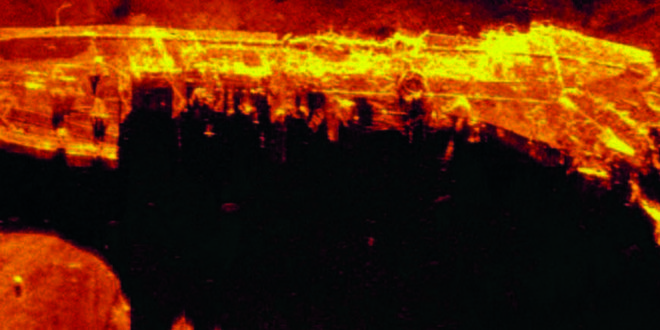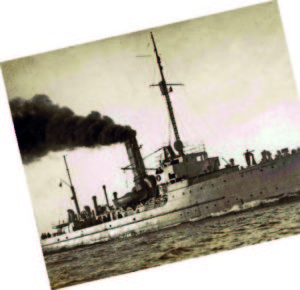
Editor’s note: In June of last year, John Nekus and a team of Lithuanian naval historians, underwater archeologists and sailors in the Lithuanian Navy lead by Dr. Vladas Žulkus of Klaipėda University sailed on what turned out to be the 3rd expedition to look for the wreck of the Prezidentas Smetona, flagship of the modern Lithuanian navy during the interwar years. The warship sank on January 11, 1945 during WWII, several years after it had been recommissioned as a Soviet minesweeper following Soviet occupation of the Baltic naval fleet. The saga of this unique naval vessel was described by Romualdas Adomavičius, a historian working at the Lithuanian Sea Museum in Klaipėda, in the March/April 2017 issue of Lithuanian Heritage. In this interview, John describes the search for the wreck, how several expeditions to find it came to be organized, and why the interest in this particular ship was especially meaningful to him personally.
LH: John, could you please share what your connection is to the pre WWII Lithuanian Navy and to this ship?
JN: The Prezidentas Smetona was purchased from Germany by the Lithuanian government in 1927. Its purpose was to protect the coastline and to interdict boats laden with contraband, and it later served as a training ship for the Lithuanian Navy. The first captain of this ship was Adomas Daugirdas, my grandfather.
LH: Could you tell me a bit more about your grandfather?
JN: Adomas was born in 1894. He trained at the Nikolaev Maritime Academy in St. Petersburg in 1916, specializing in submarine warfare. As part of his training, he participated in a sailboat trip around the world. In 1918 Adomas married my grandmother, an eye doctor, Teklė Hulevičiūtė. After returning to Lithuania in 1918, he participated in the fight for independence as a captain in the Lithuanian army. In 1923, Adomas cofounded the Lithuanian Sailors Association, and was a founding editor of the naval journal Jūra. He was captain of the Prezidentas Smetona for a short period of time. From 1933–1939 he served as Harbor Master for the port of Klaipėda.
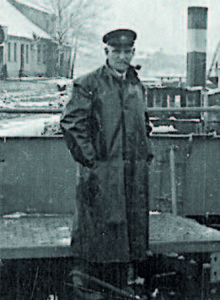
Lithuanian warship, ca. 1927.
In 1940 he fled Lithuania for the West when the Russian army occupied Lithuania, spending time initially in DP (displaced persons) camps in Germany, and then getting a visa to Canada where he lived in Sault Ste. Marie, Ontario with his wife until his death in 1979. The family included his son Jurgis and daughter Irene, my mother, who was born on May 5, 1921 in Kaunas. Irene married my father, Leonas Nekus (Nekutavičius), who was born on June 28, 1923 in Panevėžys to parents Jonas and Ona Nekutavičius. My father Leonas had one brother, Valentinas, who studied medicine in Lithuania. My mother Irene and father Leonas married in Germany in 1945 at the end of WWII after they fled Lithuania. They emigrated to Canada in 1948 as did many war refugees by obtaining transportation and work from companies in the West including Canada, South America and Australia. After completing his work obligation at a steel mill in Sault Ste. Marie, Ontario, my father Leonas and my uncle Jurgis (mother’s brother) obtained engineering degrees from Queens University in Kingston, Ontario. My father’s brother, Valentinas (Dr. Nick Nekus) married Patricia Morton in Canada and practiced medicine in Kingston, Ontario until his death in 2009. Patricia still lives in Kingston. Upon graduation, my father obtained a job at an engineering firm and moved with my mother Irene to Toronto, where my brother Andy and I were born. Our family moved to Chicago in 1960 and after a year in Marquette Park, Chicago we moved to Beverly Shores, Indiana, a small town near the Indiana Dunes on Lake Michigan where I grew up. My grandparents decided to stay up in Canada, as they loved the natural environment there, reminding them as it did of Lithuania. My mother Irene passed in 1980 and my father Leonas passed in 2009. My brother Andy and his wife Debbie have two sons, Michael and James, and live in Ridgewood, NJ. Today I live in New Buffalo, Michigan and travel to Lithuania often.
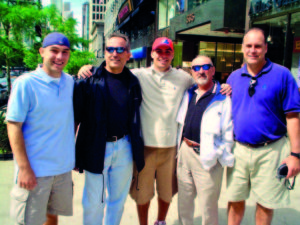
LH: As you were living apart from your grandfather, did you know him personally? What do you remember about him? Did he ever talk to you about the Prezidentas Smetona and his time as a captain in the Lithuanian navy?
JN: Our family would travel from Beverly Shores, Indiana to Canada several times a year to visit my grandparents. So I spent my teenage years and into my early twenties talking with both grandparents for hours on those visits. I recall talking to my grandfather, Adomas, about sailing and sailboats as I spent my summers on Lake Michigan racing sailboats. He would tell me about his voyage around the world in 1916 after completing Marine Academy training in St. Petersburg. I recall him describing sailing into harbor in China in 1916 and about several severe storms they experienced on that voyage. It was an amazing story.
Only years later after his death and traveling to Lithuania would I come to understand and appreciate his life and Lithuania. He would talk about the Port in Klaipėda and it seemed like a dream to me as a teenager, a place far away in another world. Today I’ve had the good fortune to see it for myself. Klaipėda and all of Lithuania is an amazing place. My mother would talk about summers in Klaipėda when she was growing up. She would describe Palanga, Nida and spending summers summers on the beaches there with her brother Jurgis. I could sense that my grandfather loved Klaipėda and missed it. Sault Ste. Marie, Ontario has a series of locks where large cargo ships and tankers sail through as they head toward the St. Lawrence Seaway and the Atlantic Ocean to the world beyond. Grandfather Adomas would drive me to the port in Sault Ste. Marie where the locks were located and we would watch the huge ships sail by for hours. He would tell me, “Jonuk, always respect the sea.”
While I knew he was a captain in Lithuania, he didn’t tell me that he was captain on the Prezidentas Smetona. I didn’t know that one day, years later, I’d be part of a group of Lithuanians searching for the warship he commanded, the Prezidentas Smetona. Just before he died, he gave me his captain’s bars from his naval uniform that he received when he was commissioned as an officer in the Lithuanian Navy. He told me that they were very special to him and asked that I take care of them for him. Years later, I brought his captain’s bars with me on our expeditions to find his warship. They brought us good luck, as he was part of our expedition team. His spirit and the spirit of many sailors in Lithuania’s long naval heritage led us safely to find this ship. I’m taking care of my grandfather’s captain’s bars as he asked.
LH: Folk wisdom is, that grandchildren often take after their grandparents. Do you see any similarities between yourself and Cpt. Adomas?
JN: That’s an interesting question. Yes, we both love the sea, sailing and Lithuania. We both live life as students of international travel, learning about different cultures along the way. I’d say my grandfather taught me that life is a positive journey with many rough seas where leadership, strength of character and loyalty to family, fellow officers and crew are important. Although I could never have imagined this as a teenager, we both sailed out of the Port of Klaipėda on a Lithuanian ship with a Lithuanian crew on voyages to the Baltic Sea. We both learned about, and as a result have a deep respect for, the Lithuanian Navy, Lithuanian history and the many sailors and people who make up the rich history of the Port of Klaipėda and Lithuanian naval heritage. And we both love Lithuanian food.
LH: What sort of ties did you have to Lithuania and Lithuanians living in Beverly Shores?
JN: Although my brother and I spoke Lithuanian at home to our parents, we never really participated much in formal Lithuanian organizations or activities growing up. Beverly Shores is home to many Lithuanian families whose parents or grandparents emigrated from Lithuania during WWII and after. That’s because Beverly Shores is near Chicago on the shores of Lake Michigan next to the Indiana Dunes and is similar to the dunes and beaches near Klaipėda, Palanga and Nida on the Baltic Sea. There were social gatherings and a Lithuanian club that exposed me to Lithuanian culture, food, language and heritage. But to be honest, as a teenager, I was more interested in sailing, high school friends, sports and girls. Like many teenagers growing up in America whose parents are from Lithuania, I’d experience Lithuanian culture, language and food at home and would also live a normal American life beyond home. I soon found out that my friends didn’t speak Lithuanian at home or eat what we did.
While my parents loved their Lithuanian heritage, they experienced first hand the reality of WWII and how life can change in an instant. Over dinner one day years later, my parents shared that after many discussions on parenting they concluded that we lived in America not Lithuania and as a result their goal as parents was to raise my brother and I to be functional and successful adults in the place where we lived. When I think about that decision being made by war refugees less than ten years removed from Lithuania and a Germany DP (displaced persons) camp, it’s humbling and I’m thankful to both of them. Interestingly, something inside drew me to Lithuania. As an adult I’d travel to Lithuania years later to find my heritage. I found a lot more in the process.
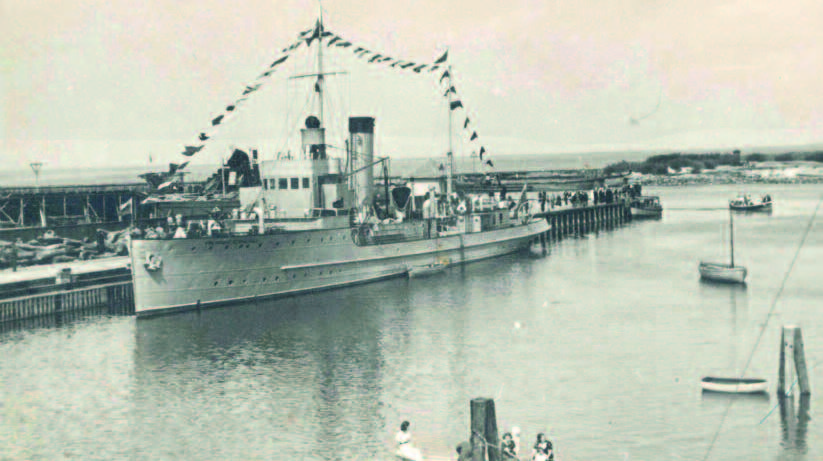
LH: When did you first become interested in the Prezidentas Smetona?
JN: Actually, I knew very little about the ship until 2005. I had started a consulting business focused on information and computer technology to the banking and financial industry that allowed me a lot of opportunities for global travel. In September of that year, I traveled to Lietuva with my brother Andy for the first time. We flew into Palanga; driving along the Klaipėda port on Naujoji Uosto street just an hour after landing we happened upon a gathering of naval officers at a Captains’ Club who were celebrating the birthday of the Harbor Master. We pulled over on Sankryžos street and I asked Cpt. Ričardas Lučka, one of the Captains attending, if he heard of my grandfather Adomas Daugirdas. Captain Lučka asked me, “are you his grandson”? I replied yes, my brother and I are here for the first time trying to learn about him and our family heritage. He said, come with me…
Captain Lučka led us inside and said they had been able to raise money and had just published a book on Lithuanian captains and naval history. He sat us down and opened the book to the second or third page and pointed to a photograph saying, “Here is your grandfather and your roots.” He introduced my brother and me to the rest of the captains attending the celebration where we learned about the Prezidentas Smetona and Lithuanian naval history, most of which I was hearing for the first time. Imagine the odds of happening upon a birthday gathering with Lithuanian captains at that place and at that time an hour after arriving on our first visit to the country? Perhaps something spiritual was guiding us? Needless to say, we celebrated together that afternoon having somehow found one another.
After returning to Chicago, I reached out to my uncle Jurgis (son of Adomas Daugirdas) to inquire about his father – my grandfather. Since then, uncle Jurgis and I have had many discussions about Adomas, the Prezidentas Smetona and family life growing up in Klaipėda. Thank you, uncle Jurgis! It so happens that the Captains’ Club building in Klaipėda was where our grandfather Adomas and family lived when he was the Harbor Master in the 1930s. My mother Irene and uncle Jurgis spent their summers living in that building. And now here I was standing in the same place.
LH: Tell us about how you decided to find the wreck.
JN: It turns out that the Rector of Klaipėda University, Dr. Vladas Žulkus, had a longstanding interest in underwater archeology and research of historical shipwrecks. He and a team of researchers were conducting sonar imaging of the Baltic Sea floor looking for shipwrecks of historical significance and diving to underwater sites. My cousin Marius Daugirdas (son of my mother’s brother Jurgis) and I traveled to Lithuania in the summer of 2006, at which time we visited the Sea Museum in Klaipėda and saw a photo of our grandfather hanging on the wall along with a photo of the Prezidentas Smetona. I took Marius to the Captains’ Club I had been to with my brother the previous year.
We learned that the Prezidentas Smetona sank at the end of WWII. After an emotional day at the Sea Museum and Captains’ Club we retired to a restaurant in Klaipėda Old Town just off the main square. Over dinner a thought came to me and I said, “We need to find that warship.” That thought would lead to an amazing journey for me. Several months later Arūnas Pemkus, a friend in Vilnius, sent me an article from the Lietuvos Rytas newspaper about Dr. Žulkus having found the wreck of the Prezidentas Smetona. I contacted prof. Žulkus from Chicago to congratulate him. He asked why someone from Chicago would be interested in this ship, and I told him Daugirdas. Dr. Žulkus replied that we needed to meet.
Later that year, prof. Žulkus and I met in Vilnius, where he told me about his research on sonar imaging of the Baltic Sea bottom. During that meeting Žulkus informed me that the ship they had found earlier that year on their initial expedition was not the Prezidentas Smetona but a different ship. I replied, “That’s not a problem because the Prezidentas Smetona is not going anywhere and we only need to have the will and resources to find it.” I told him we had a shared goal of locating the long lost ship. We shook hands and agreed to work together.
I spent the next two years traveling to Vilnius, where I created the Adomas Daugirdas Lithuanian Maritime Foundation, for the purpose of raising money for sponsorship of this and other Lithuanian maritime research expeditions. Meanwhile, Dr. Žulkus worked on the planning and technical aspects of a second expedition. I brought my nephews Mike and Jim with me on trips during this period so they could see and experience Lithuania. Why was there a wreck? After Lithuania was occupied by the Soviets during WWII, the pride of the Lithuanian Navy was recommissioned as a Soviet coast guard defense ship and mine trawler. It was renamed the Korall and was involved in naval skirmishes against the German navy. On January 11, 1945, the Korall – ex-Prezidentas Smetona sank on a voyage from Helsinki to Tallinn, in the region of Aegna Island. Stories were that a mine sank the boat; other accounts suggested that the warship was the victim of a German submarine attack. The problem was that this region was the site of many naval conflicts and battles during the second World War and as a result, the bottom of the Gulf of Finland is strewn with many shipwrecks. So there were several expeditions that believed they had identified the wreck of the Prezidentas Smetona but later, those finds turned out to be other ships.
LH: Tell us about the second expedition to find the wreck.
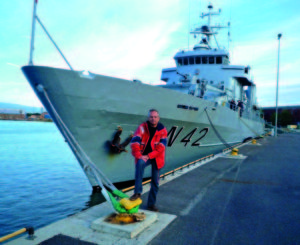
JN: In the summer of 2009, Prof. Žulkus decided to organize a second expedition to find and document the wreck site and invited me along. Dr. Žulkus asked the Lithuanian Navy for assistance. They agreed to provide the warship Jotvingis along with its officers and crew for three days to assist. The Lithuanian Navy made arrangements to collect our team at Tallinn after they completed annual training exercises with NATO warships in the north Baltic Sea. Our team of six included Vello Mass, a researcher at the Estonian Maritime Museum who has found over a thousand sunken ships during his 40-year career. It was a surreal experience for me. Here I was, born far away in another country, and yet somehow found myself on a modern Lithuanian warship with Lithuanian crew looking for the flagship of the Lithuanian Navy. You can’t make this stuff up. During this expedition we did find a shipwreck that we initially believed was the Prezidentas Smetona, but after more detailed analysis, it again turned out to be not the ship we were searching for. Our journey was not over!
LH: What happened then?
JN: In 2014, a sonar image of a new shipwreck was taken by Vello Mass, and a dive team took several underwater photos of the site. This time, the wreck was believed to be the Smetona with a relatively high degree of certainty. So Dr. Žulkus began organizing a confirmatory third expedition, which drew great interest in the Lithuanian popular press.
LH: Can you describe this third expedition and its results in detail?
JN: This third expedition took place in late June of 2017. We sailed from Klaipėda, aboard Klaipėda University’s tall ship Brabander. We sailed north for almost 600 kilometers and then into the Gulf of Finland to Tallinn. The Brabander crew included Captain Valdemaras Vizbaras; Ričardas Ramanauskas, Sr. Captain’s Assistant; Romualdas Vižulas, Sr. Mechanic; Rapolas Terleckas, 2nd Captain’s Assistant and Arūnas Molis, Sailor/Ship’s Cook. The meals prepared on board by Arūnas during our expedition were beyond good and pure Lithuanian home cooking. Ačiū, Arūnai! The expedition was again led by Dr. Žulkus and included Jūratis Liachovičius (now deceased), Director of the Palanga Cultural Museum; Dr. Valdas Rakutis, Defense Ministry Advisor; Lieutenant Valerijus Krisikaitis, Naval Reserve and Underwater Diving Instructor; Lieutenant Captain Robertas Arlauskas, Active Duty Lithuania Navy; Sergeant Martynas Latakas, Active Duty Lithuania Navy Underwater Action Command; and me, the grandson.
Our goal was to once and for all verify that this new potential wreck site was indeed the Prezidentas Smetona. Additionally we planned to locate and photograph three other historical Lithuanian ships lost during that period, including the Panevėžys, the Kretinga and the Utena. These three ships had not been found nor photographed since they sank during WWII. Our expedition team included Rimas Bružas, filmaker and journalist with LRT Television, Valdas Jarutis, photographer, and Linas Augutis, film producer from ERA Film in Vilnius, who wanted to make a historical documentary on Lithuanian naval history and our expedition to find these ships [see correction at the end of this article]. You can read a blog diary of the expedition on my Facebook page, www.facebook.com/John. Nekus, examining the timeline from June/July of 2017.
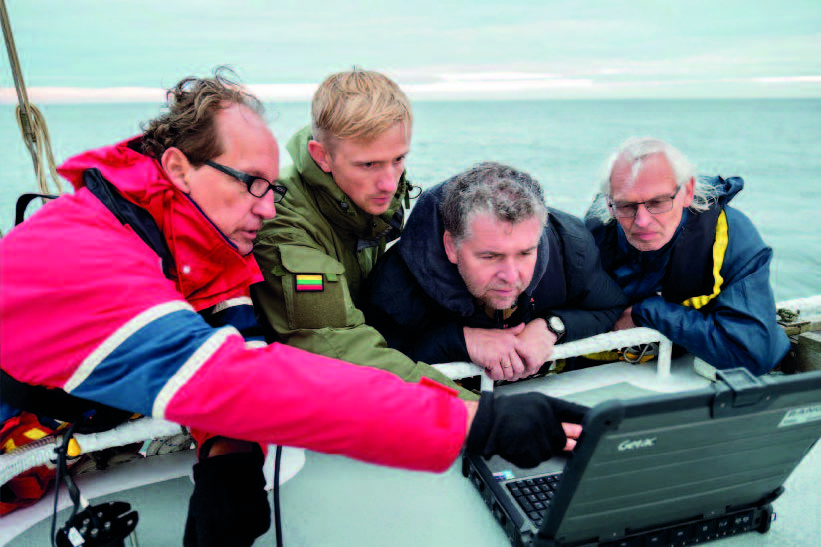
On July 2nd, we reached the wreck site of the Prezidentas Smetona and also found and examined the wreck site of the Panevėžys. Sonar images of both vessels were made, and these were the first known images of the Panevėžys. The expedition team then sailed back to the Port of Tallinn at 0600 the next morning. The following day, we departed Tallinn and sailed for five hours eastward toward St. Petersburg and Russia. The expedition plan was to conduct research at a graveyard of ships located in eastern Estonian territorial waters where the wrecks of Lithuanian historical ships Utena and Kretinga were believed to be located. During WWII, tens of thousands of mines had been laid by the German navy from Helsinki south to Estonia, to prevent the Russian Baltic Fleet from exiting St. Petersburg. Over 64 ships and 2,400 sailors were lost in the area we would be researching. We did find the Utena and Kretinga wreck sites as well, and so were ultimately successful in finding and photographing all four historical Lithuanian warships. The venture was a resounding success! We finished our sonar imaging and sailed back to Tallinn, just beating an advancing storm.
All expedition participants had an amazing experience. Many thanks are owed to the Lithuanian Navy, Klaipėda University, the Lithuanian Maritime Foundation, ERA Film, LRT Television and the entire expedition team. Rimas Bružas created a film about our expedition that aired on LRT last year. Rasa Miškinytė of ERA Film released a historical documentary on our expedition in December of 2017 that was shown on LRT on February 26, 2018. I traveled to Klaipėda in December to be reunited with the expedition participants for the initial screening of this film. The link to see this film is at: http://www.lrt.lt/mediateka/ irasas/1013685957/prezidentinis- karo-laivas-dok-f
LH: So, now that the Prezidentas Smetona has been found, what are your final thoughts on this experience?
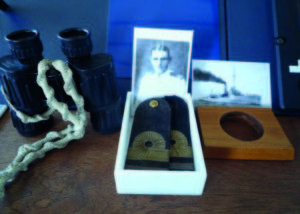
JN: I think each person has a yearning to understand their heritage and roots. I was fortunate to have had an opportunity to better understand my heritage through my grandfather Adomas Daugirdas. Lithuania and its naval tradition has a long and complex history. Many Lithuania after WWII during Soviet occupation or whether they fled Lithuania during WWII through war-ravaged Poland and Germany, and then emigrating to the West, experienced extreme hardship. They learned how to survive and were driven by love of country, heritage and family. They learned to persevere during life challenges and in stormy seas.
In 2018, Lithuania celebrates the 100-year anniversary of its reestablishment as an independent country. The Prezidentas Smetona is an important symbol of Lithuania’s independence and nationhood during the interwar period, in which all Lithuanians can take pride.
This experience brought me in touch with my Lithuanian heritage. When I stepped off the plane in Palanga airport on that first trip to Lithuania in 2005, I was overwhelmed with a feeling that I had finally found my homeland. I remember kneeling and kissing the ground. I’ve returned to Lithuania many times since. I’ve experienced this journey with a group of Lithuanians who are passionate about Lithuania and seek to preseve its rich naval history. I respect each of them and admire their achievements. We were brought together from various walks of life and became “Smetona brothers” (Smetonos broliai) during this expedition. Last year we lost one of our Smetona brothers, Jūratis Liachovičius, who passed suddenly a couple of months after our expedition had been completed. His positive spirit, love of life, wit, humor and love of the sea will be missed. Going forward, we want to raise funds so that we can return to the Prezidentas Smetona wreck site on a future expedition to send underwater divers and a Remotely Operated Vehicle (ROV) to the wreck and record high resolution images and video. The journey is not over. There are many historical ships at the bottom of the Baltic Sea waiting to be found. We only need the will and resources to find them…
Correction: (June 22, 2018)
On page 10 in the article I stated incorrectly that “Linas Augutis was the producer from ERA Film in Vilnius, who wanted to make a historical documentary on Lithuanian naval history and our expedition to find these ships”. In fact it was Rasa Miškinytė who was the producer of the film President’s Warship (“Prezidentinis Karo Laivas”) and the inspiration behind it. Rasa Miškinytė invited Linas Augutis to direct the film. Both Rasa and Linas were wonderful to work with. Thank you to both of them and to ERA Film.
 DRAUGAS NEWS Lithuanian World Wide News in English
DRAUGAS NEWS Lithuanian World Wide News in English
